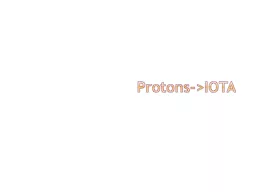

Eric Prebys FNAL Background The IOTA project recently received strong endorsement from the P5 Accelerator RampD subpanel who specifically recommended even in scenario A bleakest scenario Construct the IOTA ring and conduct experimental studies of highcurrent beam dynamics in integrab ID: 528526
Download Presentation The PPT/PDF document "Protons->IOTA" is the property of its rightful owner. Permission is granted to download and print the materials on this web site for personal, non-commercial use only, and to display it on your personal computer provided you do not modify the materials and that you retain all copyright notices contained in the materials. By downloading content from our website, you accept the terms of this agreement.
Slide1
Protons->IOTA
Eric Prebys, FNALSlide2
Background
The IOTA project recently received strong endorsement from the P5 Accelerator R&D subpanel, who specifically recommended even in scenario A (bleakest scenario)
“Construct the IOTA ring, and conduct experimental studies of high-current beam dynamics in integrable non-linear focusing systems.
The plan is to initially test the ring using 150 MeV electrons from the ASTA facility, but to ultimately test the ring with protons, in order to fully its potential to compensate for space charge effects.The IOTA proton program will initially use the RFQ that was originally built for the HINS (Project-X front end) test program.
Protons->IOTA, May 18, 2015 - E. Prebys
2Slide3
RFQ Design and Specifications
Protons->IOTA, May 18, 2015 - E. Prebys
3
Pulsed 4-vane
RFQ (specs):Slide4
Rate Limitation
HINS was designed to operate at a 1% duty factor
Large tune shifts were seen at the .1% level (~Hz x ~mA)
A design flaw caused water leaks at ~30 cooling channel couplings within the RFQ, such that vacuum could not be maintained-> No coolingIncreased temperature resulted in the observed tune shifts.Bad for them, but no problem for us.
Protons->IOTA, May 18, 2015 - E. Prebys
4
As the RFQ heats up, this flange bulges, causing a parasitic mode to mix and shift the resonant frequencySlide5
Protons->IOTA, May 18, 2015 - E. Prebys
HINS Proton Source
Arrangement*
HINS proton source is a re-configured, and much improved Loma Linda Ion
Source (1989).
Major changes include:
Increased operational HV from 30 kV to 50 kV
Increased beam pulse duration from 65
μ
s @ 15 Hz to 3
ms
@ 2.5 Hz (8 times higher beam power)
Installed new, 7 times stronger vacuum system
Installed digitally controlled supporting electronics for all ion source subsystems (HV, LV, H2 flow, vacuum, magnets, etc.)Ion source operations are fully directed from HINS Main Console
*H.
Piekarz
5Slide6
HINS Parameters for IOTA
Protons->IOTA, May 18, 2015 - E. Prebys
6
matched to IOTA momentum, but
β=.073!
misreported as 2.
Why no one will steal this RFQ from us
Is this big enough?
Demonstrated for 1
ms
pulses. Should go to >40 mA for short pulses. I recommend we assume that.Slide7
Emittance issues
4
p
-mm-mr is a very large emittance for this ringWould be nice to go to a higher tune shiftThis beam will scrape on the non-linear insertsIt’s hoped that the emmittance will be somewhat smaller for a short pulse, or we could scrape a 40 mA beam down to a lower emittance.Recall, if you scrape in both planes
Could still go to unity tune shifts with half the emittance.
Protons->IOTA, May 18, 2015 - E. Prebys
7
Most people (including me) forget thisSlide8
HINS RFQ Layout for IOTA
We will initially use a protons source, and the same injection
Lamberstson
and kicker as the electronsProtons->IOTA, May 18, 2015 - E. Prebys
8
S.
AntipovSlide9
RF System
The electrons will use a 1 kV, h=4, 30 MHz RF system.
For protons, this would be h=56, and 1 kV would only bunch ~1/3 of the protons (enough for BPMs)
Plan is to build a dual cavity, with an h=4 part for protonsProtons->IOTA, May 18, 2015 - E. Prebys
9Slide10
Fermilab activities
Fermilab activities have focused primarily on the technical aspects of installing the proton source
The ion source, RFQ, and klystron were left in place, but all supporting hardware was cannibalized for PXIE (vacuum, HV,
etc)Very little money until FY17Hope to resurrect ion source this year and RFQ next year in current locationMove to NML in FY17
Currently working onIon source refurbishment: Henryk Piekarz
Transfer line design: Sergei
Antipov
RF system: Kermit Carlson
General engineering: Jerry
Liebfritz
Vacuum (more demanding for protons): Lucy
Nobrega
Synergia
simulations: Eric PrebysInstrumentation: Vic Scarpine and Randy Thurman-Keup
Protons->IOTA, May 18, 2015 - E. Prebys
10Slide11
Lots of places for collaboration
Simulations
Cross-checks are important
InstrumentationStill need a good way to measure profilesExperimental programWhat will we do with protons once we have them?Improvements to sourceWhat can we hope to get out of this?Longer term upgrades
Ion injection?Protons->IOTA, May 18, 2015 - E. Prebys
11Slide12
Possible Future Upgrade: H- injection
Install a stripping foil in the 30° bend?
Still investigating bump configuration
Just a cartoon at this point. Not currently scoped.
Protons->IOTA, May 18, 2015 - E. Prebys
12Slide13
Hope for this meeting
Who wants to do what?
Agree on standard set of starting assumption
Frequency/time of meetings (does this slot work?)Protons->IOTA, May 18, 2015 - E. Prebys
13